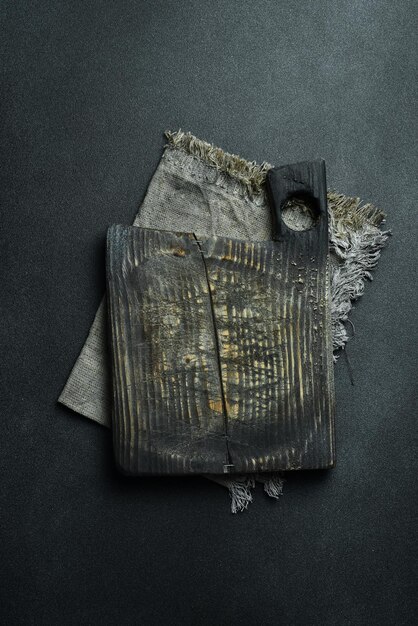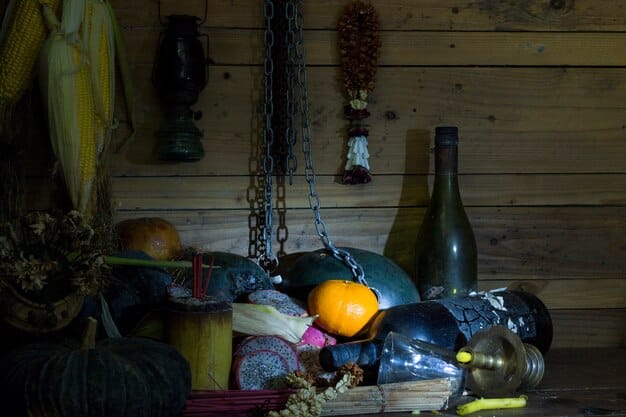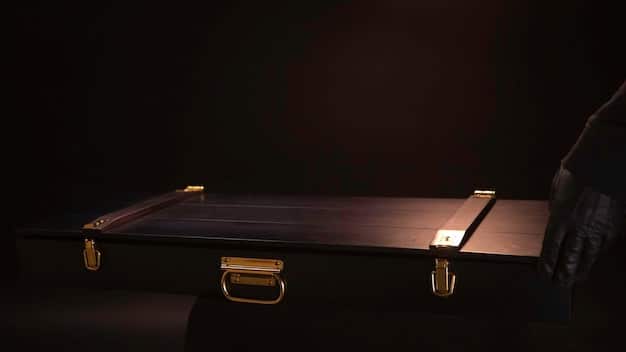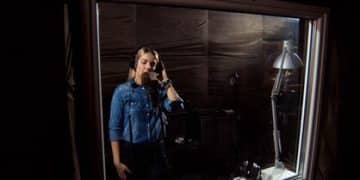Unveiling Movie Secrets: The Props That Held Hidden Ending Clues

The Props That Held Hidden Clues to the Ending of [Movie Title] often go unnoticed, yet they are meticulously placed to foreshadow events, reveal character arcs, enrich the narrative, and sometimes, subtly hint at the film’s ultimate conclusion.
Movies are often a complex tapestry of visuals and storytelling, and one of the most subtle yet powerful tools filmmakers use is the strategic placement of props. But what if those seemingly innocuous items held the keys to understanding the climax? Join us as we delve into the props that held hidden clues to the ending of [Movie Title].
The Art of Foreshadowing Through Props
Foreshadowing is a literary device used to give an indication or hint of what’s to come later in the story. In film, this is often achieved through visual cues, and props are an essential element in creating these subtle hints. They can be seemingly insignificant items that later take on a much deeper meaning.
Symbolism in Set Design
Set design plays a crucial role in setting the atmosphere and tone of a movie, and within that, props act as subtle messengers. From the color of an object to its condition, every detail is carefully considered to add layers of meaning.
Props as Character Indicators
A character’s choice of possessions and how they interact with them often reveals a great deal about their personality, motivations, and ultimately, their fate. A seemingly minor item can become a powerful symbol of who they are.
- A broken watch might hint at a character’s inability to control their destiny.
- A recurring floral arrangement could symbolize a character’s emotional state.
- A specific book could foreshadow a character’s intellectual prowess or demise.
By paying attention to these details, viewers can often piece together the bigger picture and anticipate twists and turns in the plot. These clues allow the audience to engage more deeply with the narrative and anticipate the ending. The strategic deployment of props underscores the director’s masterful manipulation of visual language.

Recurring Motifs and Symbolic Objects
Certain props recur throughout a film, often appearing at pivotal moments. These aren’t just decorative items; they are motifs that carry significant weight and often symbolize the underlying themes of the narrative.
The Power of Repetition
When the same object appears repeatedly, it’s a clear sign that the filmmaker wants the audience to pay attention. Each appearance builds on the object’s established meaning and can shift its interpretation as the story progresses.
Symbolic Significance
Objects can be imbued with symbolism to represent complex ideas, emotions, or themes. For example, a birdcage might symbolize confinement, while a key could represent freedom or opportunity.
- Mirrors often serve as symbols of self-reflection or hidden truths.
- Photographs can represent memories, both cherished and haunting.
- Maps might symbolize journeys or hidden paths to discovery.
These recurring motifs provide a deeper understanding of the narrative’s core messages. These objects become threads that weave together different parts of the story, guiding the audience towards a more profound understanding of the characters and their fates. Recognizing these symbols enriches the viewing experience, revealing hidden layers of meaning that might otherwise go unnoticed.
Color Coordination and Prop Placement
Filmmakers use color and placement meticulously to influence the audience’s perception. Color coordination in props and the arrangement of these items within a scene can subtly reveal crucial story elements.
The Psychology of Color
Colors have specific psychological associations that filmmakers exploit to evoke certain emotions or foreshadow events. For example, red often signifies danger or passion, while blue might represent calmness or sadness.
Strategic Placement
Where a prop is placed within the frame can also contribute to its significance. An object positioned prominently in the foreground will naturally draw the viewer’s eye, suggesting its importance.
- A single red rose on a table can foreshadow a character’s doomed love.
- A shadow falling over an object could hint at impending darkness or trouble.
- The arrangement of items in a character’s room can reveal their state of mind.
By understanding the intentional use of color and placement, perceptive viewers can gain deeper insights into the narrative’s direction. These elements underscore the visual storytelling techniques employed by the director, enhancing the film’s overall impact.
The MacGuffin: When a Prop Drives the Plot
In filmmaking, a MacGuffin is a plot device that motivates the characters and drives the story forward, and it’s often a prop of great importance. Although the MacGuffin itself is not the main focus, it plays a crucial role in shaping the narrative’s course.
Defining the MacGuffin
A MacGuffin can be any object, person, or event that serves as a catalyst for the characters’ actions. It’s the “thing” that everyone is after, regardless of its true significance.
Examples of MacGuffins in Film History
From the Maltese Falcon in the film of the same name to the One Ring in “The Lord of the Rings,” MacGuffins have taken many forms throughout cinematic history.

- The briefcase in “Pulp Fiction” whose contents are never fully revealed, but drive the characters’ actions.
- The plans for the Death Star in “Star Wars: A New Hope,” which are essential to the Rebel Alliance’s mission.
- Dorothy’s ruby slippers in “The Wizard of Oz,” which are coveted by the Wicked Witch of the West.
The power of a MacGuffin lies in its ability to provide a clear objective for the characters, no matter how arbitrary or subjective. The narrative focuses on the pursuit and handling of the MacGuffin, driving the story to its ultimate conclusion. Often, the MacGuffin is less important than the characters’ journeys to obtain or protect it.
Hidden Details in Plain Sight
Sometimes, the most significant clues are hidden in plain sight. Seemingly ordinary props can contain details that hint at future events or reveal deeper truths about the characters.
The Art of Misdirection
Filmmakers often use misdirection to distract the audience from noticing these subtle clues. By drawing attention to something else, they can hide important details in the background.
Revealing Character Secrets
A character might possess an item that hints at a hidden past or a secret desire. These objects can provide a deeper understanding of their motivations and behavior.
- A character’s old photograph can reveal a past relationship or a hidden identity.
- A seemingly innocuous letter can contain a confession or a warning.
- A specific tattoo can hint at a character’s affiliation with a secret society.
By paying close attention to these details, viewers can uncover hidden layers of meaning and gain a more profound appreciation for the storytelling. These hidden elements contribute to a more complex and rewarding viewing experience, inviting audiences to re-watch and analyze the film for further discoveries. The power of these subtle clues lies in their ability to enrich the narrative without being overtly obvious.
Analyzing Specific Examples from Film History
Examining specific films can highlight how props have been used to foreshadow endings and enrich narratives. These examples showcase the creativity and intentionality behind the selection and placement of props.
Case Study: “The Sixth Sense”
In “The Sixth Sense,” the red color appears whenever death is about to happen or when Malcolm Crowe interacts with a ghost. This subtle visual cue prepares the audience for the film’s shocking reveal.
Case Study: “Fight Club”
In “Fight Club,” Tyler Durden appears in fleeting images throughout the first act, long before he’s formally “introduced” as a character. These subliminal appearances foreshadow the twist regarding his true identity.
- In “The Usual Suspects,” the bulletin board in the detective’s office contains names and details that ultimately inspire Verbal’s fabricated story.
- In “Memento,” the Polaroid photographs help Leonard track his progress, but also mislead him due to his unreliable memory.
- In “Arrival,” Louise Banks’ visions of the future are triggered by her interactions with the alien language, subtly foreshadowing her ultimate choice.
Analyzing these films reveals the power of props and subtle visual cues in shaping the audience’s experience and understanding. These examples demonstrate how filmmakers use props to enhance the narrative, inviting attentive viewers to unravel the layers of meaning hidden within the film.
Conclusion
Props are more than mere set dressing; they are vital storytelling tools that can foreshadow events, reveal character arcs, and enrich the narrative. By paying close attention to the props that held hidden clues to the ending of [Movie Title], viewers can unlock a deeper understanding of the film and appreciate the artistry and intentionality behind its creation. So, next time you watch a movie, keep a keen eye on the objects that populate the screen – you might just uncover the secrets they hold.
| Key Point | Brief Description |
|---|---|
| 🔍 Foreshadowing | Props hinting at future events. |
| 🎭 Symbolism | Props representing deeper themes. |
| 🎨 Color & Placement | Strategic use to influence perception. |
| 🎬 MacGuffin | Drives the plot forward. |
FAQ: Decoding Movie Props
▼
Props are crucial for adding depth, symbolism, and foreshadowing to a film. They enhance visual storytelling, helping to convey character traits, plot hints, and thematic elements without relying solely on dialogue.
▼
Props foreshadow events by subtly hinting at future developments through symbolic representations or repeated appearances. A specific object might gain significance over time, signaling a turning point or revelation.
▼
A MacGuffin is a plot device, usually an object, that motivates the characters and drives the story forward. Its importance lies not in its intrinsic value but in its ability to fuel the characters’ actions and decisions.
▼
Color coding of props taps into psychological associations to evoke specific emotions or foreshadow events. Red commonly signals danger or passion, while blue often represents calmness or sadness.
▼
Iconic movie props include the Maltese Falcon from “The Maltese Falcon,” the One Ring from “The Lord of the Rings,” and Dorothy’s ruby slippers from “The Wizard of Oz,” each driving the plot in unique ways.
Conclusion
In conclusion, analyzing the props used in films provides a fascinating insight into the art of visual storytelling. By understanding how filmmakers use objects to foreshadow events, symbolize themes, and drive the plot, viewers can gain a deeper appreciation for the complexities of cinema. Keep these insights in mind during your next movie night!
![Special Effects Secrets: Making [Movie Title] Magic for Under $50K Special Effects Secrets: Making [Movie Title] Magic for Under $50K - Cover Image](https://endingnew.com/wp-content/uploads/2025/06/endingnew.com_13_1749558769_a0223f59_cover-360x180.jpg)
![The Music Behind the Magic: Unpacking the [Movie Title] Score The Music Behind the Magic: Unpacking the [Movie Title] Score - Cover Image](https://endingnew.com/wp-content/uploads/2025/06/endingnew.com_13_1749558769_5379e62d_cover-360x180.jpg)
![Unveiling the Secrets: Costume Design in [Show Title]'s Finale Unveiling the Secrets: Costume Design in [Show Title]'s Finale - Cover Image](https://endingnew.com/wp-content/uploads/2025/06/endingnew.com_13_1749558836_c21c77d2_cover-360x180.jpg)


